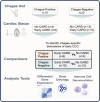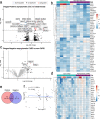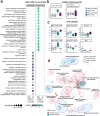This is a preprint.
Immunologic changes are detectable in the peripheral blood transcriptome of clinically asymptomatic Chagas cardiomyopathy patients
- PMID: 37873108
- PMCID: PMC10592925
- DOI: 10.1101/2023.10.03.560680
Immunologic changes are detectable in the peripheral blood transcriptome of clinically asymptomatic Chagas cardiomyopathy patients
Update in
-
Immunologic changes in the peripheral blood transcriptome of individuals with early-stage chronic Chagas cardiomyopathy: a cross-sectional study.Lancet Reg Health Am. 2025 Apr 17;45:101090. doi: 10.1016/j.lana.2025.101090. eCollection 2025 May. Lancet Reg Health Am. 2025. PMID: 40290486 Free PMC article.
Abstract
Chagas disease, caused by the protozoan parasite Trypanosoma cruzi, is a neglected parasitic disease that affects approximately 6 million individuals worldwide. Of those infected, 20-30% will go on to develop chronic Chagas cardiomyopathy (CCC), and ultimately many of these individuals will progress to advanced heart failure. The mechanism by which this progression occurs is poorly understood, as few studies have focused on early CCC. In this study, we sought to understand the physiologic changes associated with T. cruzi infection and the development of CCC. We analyzed gene expression in the peripheral blood of asymptomatic Chagas patients with early structural heart disease, Chagas patients without any signs or symptoms of disease, and Chagas-negative patients with and without early structural heart disease. Our analysis shows that early CCC was associated with a downregulation of various peripheral immune response genes, with gene expression changes suggestive of reduced antigen presentation and T cell activation. Notably, these genes and processes were distinct from those of early cardiomyopathy in Chagas-negative patients, suggesting that the processes mediating CCC may be unique from those mediating progression to other cardiomyopathies. This work highlights the importance of the immune response in early CCC, providing insight into the early pathogenesis of this disease. The changes we have identified may serve as biomarkers of progression and could inform strategies for the treatment of CCC in its early stages, before significant cardiac damage has occurred.
Conflict of interest statement
Potential conflicts of interest: Y. E. C.-S. reports nonfinancial support from InBios International Inc. during the conduct of the study and outside the submitted work.
Figures



Similar articles
-
Immunologic changes in the peripheral blood transcriptome of individuals with early-stage chronic Chagas cardiomyopathy: a cross-sectional study.Lancet Reg Health Am. 2025 Apr 17;45:101090. doi: 10.1016/j.lana.2025.101090. eCollection 2025 May. Lancet Reg Health Am. 2025. PMID: 40290486 Free PMC article.
-
Different Transcriptomic Response to T. cruzi Infection in hiPSC-Derived Cardiomyocytes From Chagas Disease Patients With and Without Chronic Cardiomyopathy.Front Cell Infect Microbiol. 2022 Jul 7;12:904747. doi: 10.3389/fcimb.2022.904747. eCollection 2022. Front Cell Infect Microbiol. 2022. PMID: 35873155 Free PMC article.
-
Cardiac and Digestive Forms of Chagas Disease: An Update on Pathogenesis, Genetics, and Therapeutic Targets.Mediators Inflamm. 2025 Apr 21;2025:8862004. doi: 10.1155/mi/8862004. eCollection 2025. Mediators Inflamm. 2025. PMID: 40297326 Free PMC article. Review.
-
Blood Gene Signatures of Chagas Cardiomyopathy With or Without Ventricular Dysfunction.J Infect Dis. 2017 Feb 1;215(3):387-395. doi: 10.1093/infdis/jiw540. J Infect Dis. 2017. PMID: 28003350 Free PMC article.
-
Chagas disease cardiomyopathy: immunopathology and genetics.Mediators Inflamm. 2014;2014:683230. doi: 10.1155/2014/683230. Epub 2014 Aug 19. Mediators Inflamm. 2014. PMID: 25210230 Free PMC article. Review.
References
-
- PAHO/WHO Chagas Disease in the Americas for General Public; 2020. 2020.
-
- Mills R.M., Chagas Disease: Epidemiology and Barriers to Treatment. Am J Med, 2020. 133(11): p. 1262–1265. - PubMed
-
- Prata A., Clinical and epidemiological aspects of Chagas disease. Lancet Infect Dis, 2001. 1(2): p. 92–100. - PubMed
-
- Nunes M.C.P., et al., Chagas Cardiomyopathy: An Update of Current Clinical Knowledge and Management: A Scientific Statement From the American Heart Association. Circulation, 2018. 138(12): p. e169–e209. - PubMed
Publication types
Grants and funding
LinkOut - more resources
Full Text Sources
